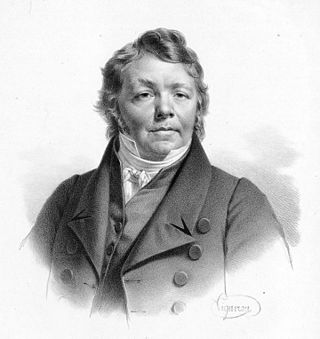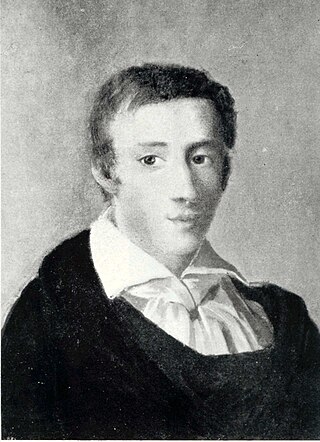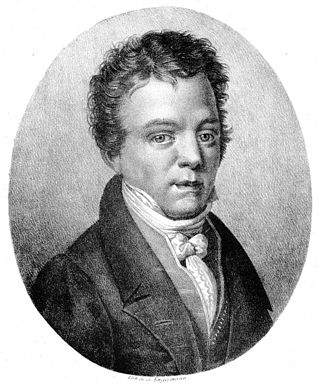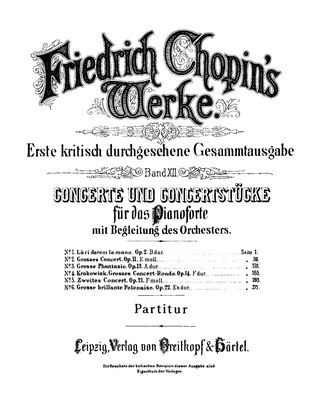Related Research Articles
This is a list of music-related events in 1810.

Johann Nepomuk Hummel was an Austrian composer and virtuoso pianist. His music reflects the transition from the Classical to the Romantic musical era. He was a pupil of Mozart, Salieri and Haydn. He also knew Beethoven and Schubert.

A piano concerto, a type of concerto, is a solo composition in the classical music genre which is composed for piano accompanied by an orchestra or other large ensemble. Piano concertos are typically virtuosic showpieces which require an advanced level of technique. Piano concertos are typically written out in music notation, including sheet music for the pianist, orchestral parts, and a full score for the conductor.

The Piano Concerto No. 20 in D minor, K. 466, was composed by Wolfgang Amadeus Mozart in 1785. The first performance took place at the Mehlgrube Casino in Vienna on 11 February 1785, with the composer as the soloist.
E major is a major scale based on E, consisting of the pitches E, F♯, G♯, A, B, C♯, and D♯. Its key signature has four sharps. Its relative minor is C-sharp minor and its parallel minor is E minor. Its enharmonic equivalent, F-flat major, has six flats and the double-flat B, which makes that key less convenient to use.

Ferdinand (von) Hiller was a German composer, conductor, pianist, writer and music director.

The Piano Concerto No. 1 in E minor, Op. 11, is a piano concerto written by Frédéric Chopin in 1830, when he was twenty years old. It was first performed on 12 October of that year, at the Teatr Narodowy in Warsaw, Poland, with the composer as soloist, during one of his "farewell" concerts before leaving Poland.
A minor is a minor scale based on A, with the pitches A, B, C, D, E, F, and G. Its key signature has no flats and no sharps. Its relative major is C major and its parallel major is A major.
F-sharp minor is a minor scale based on F♯, consisting of the pitches F♯, G♯, A, B, C♯, D, and E. Its key signature has three sharps. Its relative major is A major and its parallel major is F-sharp major.

Jan Václav Hugo Voříšek was a Czech composer, pianist, and organist.

The Piano Concerto No. 25 in C major, K. 503, was completed by Wolfgang Amadeus Mozart on December 4, 1786, alongside the Prague Symphony, K. 504. Although two more concertos would later follow, this work is the last of what are considered the twelve great piano concertos written in Vienna between 1784 and 1786. Chronologically the work is the 21st of Mozart's 23 original piano concertos.
Johann Nepomuk Hummel completed his Concerto a Trombe Principale in December 1803. It was performed on New Year's Day 1804 to mark Hummel's entrance into the court orchestra of Nikolaus II, Prince Esterházy as Haydn's successor.
Johann Nepomuk Hummel's Piano Concerto No. 3 in B minor, Op. 89 was composed in Vienna in 1819 and published in Leipzig in 1821.

Joseph Christoph Kessler, also seen as Kötzler, was a German pianist and composer who was active mostly in the Austrian Empire. His études, nocturnes, variations, preludes and bagatelles were praised by such people as Franz Liszt, Sigismond Thalberg, Ignaz Moscheles and Friedrich Kalkbrenner, and he was the dedicatee of the 24 Preludes, Op. 28 by Frédéric Chopin.

Christian Ludwig Schuncke was a German pianist and composer, and close friend of Robert Schumann. His early promise was eclipsed by his death from tuberculosis at the age of 23.
Piano Concerto No. 3 in C-sharp minor, Op. 55, by German composer Ferdinand Ries was written around 1813. It was composed in the proto-Romantic style, similar to the concertos of Johann Nepomuk Hummel, and anticipates stylistic developments of future Romantic composers.

The Piano Concerto No. 6 in C major, Op. 123, by Ferdinand Ries was composed around 1806. Composed in a proto-Romantic style, similar to the concertos of Johann Nepomuk Hummel, it also shows evidence of the influence of Beethoven's C minor Piano Concerto, Op. 37 which Ries had performed at his public debut in 1804.
The Piano Concerto No. 8 in A-flat major, Op. 151 "Gruss an den Rhein", by Ferdinand Ries was composed around 1826 and published in 1829 by Simrock. While still showing the structural influence of Beethoven's piano concertos, the writing for the piano is more akin to that of later composers such as Chopin, Mendelssohn & Schumann.

Frédéric Chopin's compositions for piano and orchestra originated from the late 1820s to the early 1830s, and comprise three concert pieces he composed 1827–1828, while a student at the Central School of Music in Warsaw, two piano concertos, completed and premièred between finishing his studies and leaving Poland, and later drafts, resulting in two more published works. Among these, and the other works in the brilliant style which Chopin composed in this period, the concertos are the most accomplished ones.

Johann Nepomuk Hummel's Piano Sonata No. 5 in F-sharp minor, Op. 81 was written and published in 1819. The work is written in a proto-Romantic style that anticipates the later stylistic developments of composers such as Frédéric Chopin, Franz Liszt, Robert Schumann, Charles-Valentin Alkan, Felix Mendelssohn, and Johannes Brahms.
References
- M.F. Humphries, The Piano Concertos of Johann Nepomuk Hummel, PhD Dissertation (Northwestern University, 1957)
- B.H. Kim, Johann Nepomuk Hummel and His Contribution to Piano Music and the Art of Playing the Piano (University of Rochester, 1967)